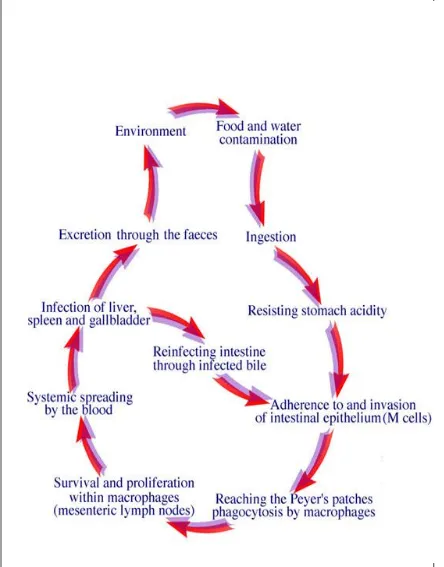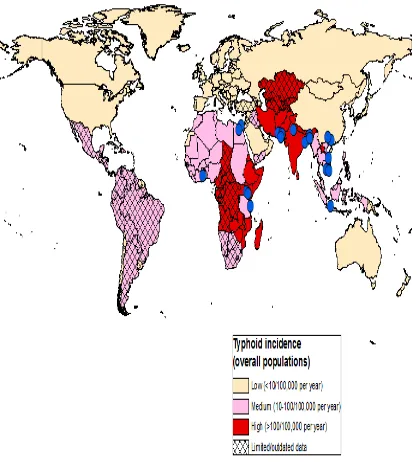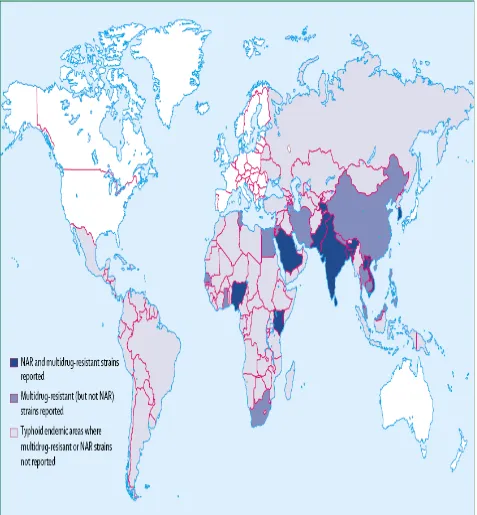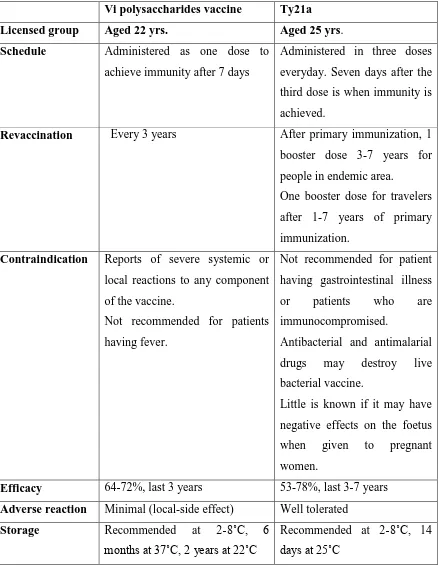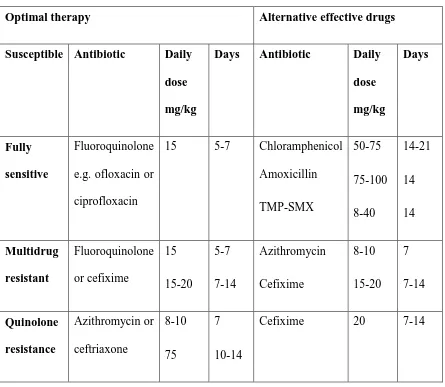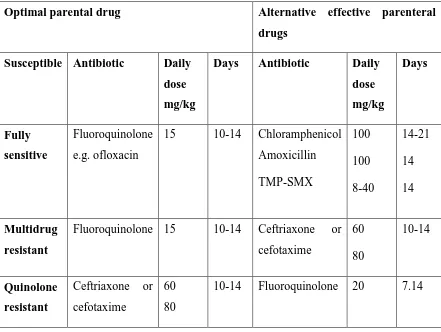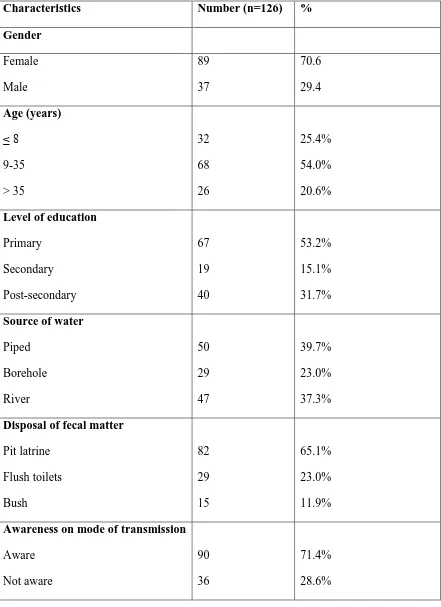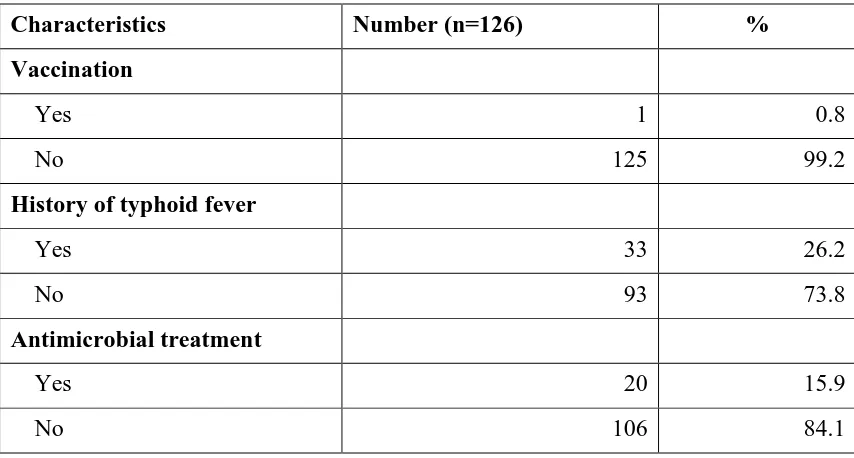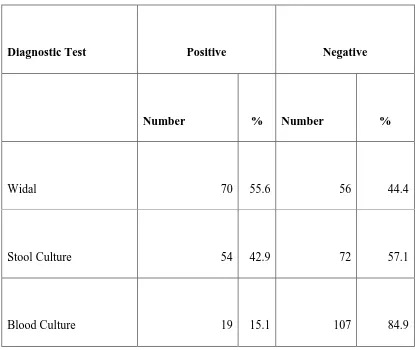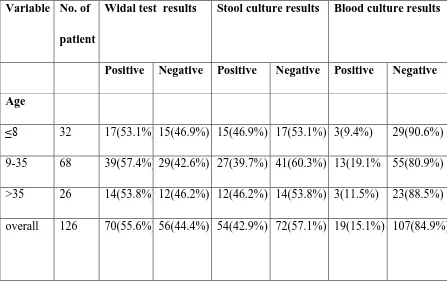PERFORMANCE OF WIDAL TEST AND STOOL CULTURE AS DIAGNOSTIC METHODS FOR SALMONELLA TYPHI INFECTION IN CHUKA GENERAL HOSPITAL, THARAKA NITHI COUNTY
Gitonga Ciriaka Muthoni, B. Ed. (Sc.) Reg. No. I56/CE/26000/2011
A thesis submitted in partial fulfillment of the requirements for the award of the degree of Master of Science (Immunology) in the School of Pure and Applied Sciences of Kenyatta University
DECLARATION
This thesis is my original work and has not been presented for the award of a degree in any other university.
Gitonga Ciriaka Muthoni
Department of Zoological Sciences Kenyatta University
Signature………Date.………
SUPERVISOR’S APPROVAL
This thesis has been submitted for examination with our full approval as university supervisors
Prof. Michael Gicheru
Department of Zoological Sciences Kenyatta University
Signature……….. ……...Date………
Dr. Joshua Mutiso
Department of Zoological Sciences Kenyatta University
DEDICATION
ACKNOWLEDGEMENTS
TABLE OF CONTENTS
DECLARATION………...ii
DEDICATION……….iii
ACKNOWLEDGEMENT………...iv
TABLE OF CONTENTS………..………...v
LIST OF TABLES ………...x
LIST OF FIGURES………..………...………….………xi
ACRONYMS AND ABBREVIATIONS………...……….. ixii
ABSTRACT………...xi
CHAPTER ONE: INTRODUCTION………..…………1
1.1 Background Information ... 1
1.2 Problem Statement ... 2
1.3 Justification of the Study ... 3
1.4 Research Questions ... 3
1.5 Hypothesis... 4
1.6 Objectives of the Study ... 4
1.6.1 General objective ... 4
1.6.2 Specific objectives ... 4
CHAPTER TWO: LITERATURE REVIEW………...……….……….6
2.1 Typhoid fever ... 6
2.1.1 Pathology………6
2.2 Epidemiology of typhoid fever ... 8
2.3 Clinical presentation of typhoid fever ... 13
2.4 Transmission and risk factors ... 13
2.5 Immune response to Salmonella ... 15
2.5.1 Innate immune response ... 16
2.5.2 Acquired immune response... 18
2.5.2.1 Role of T cells during the immune response………...18
2.5.2.2 Role of antibodies in immunity against Salmonella………18
2.6 Salmonella survival mechanisms………....19
2.7 Prevention of typhoid fever ... 19
2.7.1 Safe water and food ... 19
2.7.2 Proper sanitation ... 20
2.7.3. Health education ... 20
2.7.4 Typhoid fever vaccines ... 21
2.8 Diagnosis of typhoid fever ... 24
2.8.2 Culture methods ... 27
2.8.2.1 Stool culture method………..27
2.8.2.2 Blood culture method ... 28
2.8.2.3 Blood culture to PCR as gold standard for diagnosis of typhoid fever…...29
2.8.2.4 Colony characteristics in culture media……….30
2.9 Treatment of typhoid fever…...………...31
2.9.1 General management ... 32
2.9.2 Treatment for complicated typhoid ... 33
2.10 Resistance of S. typhi to antibiotics ... 35
2.10.1 Possible mis-diagnosis induced drug resistance……….36
CHAPTER THREE: MATERIALS AND METHODS………...37
3.1 Study Area ... 37
3.2 Study Population ... 37
3.3 Research design………..………….38
3.3.1 inclusion criteria………...38
3.3.2 Exclusion criteria ... 38
3.4 Sample size calculation ... 38
3.5 Specimen Collection ... 39
3.5.1 Blood collection……… ……….39
3.6 Laboratory Analysis ... 40
3.6.1 Widal test ... 40
3.6.1.1 Standard tube test method……….40
3.6.1.2 Slide test procedure………41
3.6.2 Stool culture ... 41
3.6.3 Blood culture ... 42
3.7 Data Management and Statistical Analysis ... 42
3.8 Ethical approval ... 43
CHAPTER FOUR: RESULTS………..44
4.1 Demographic characteristics of the study participants ... 44
4.2 Factors that may affect result of typhoid fever diagnostic tests……….46
4.3: Diagnostic Tests ... 47
4.4: Percentage prevalence of typhoid based on age and gender ... 50
4.5 Performance of diagnostic tests………...49
4.6. Prevalence of typhoid fever and associated factors………50
CHAPTER FIVE: DISCUSSION……….………...……..54
5.1 Prevalence of typhoid fever ... 54
5.2 Widal test ... 56
5.3 Stool Culture ... 58
5.5 Factors Predictive of Typhoid Fever... 60
CHAPTER SIX: CONCLUSIONS AND RECOMMENDATIONS…..……….61
6.1 Conclusions ... 61
6.2 Recommendations ... 62
REFERENCES………..…….……...64
APPENDICES………...69
Appendix I: Map of study area………..69
Appendix II: Gram's stain procedure……….70
Appendix III: Preparation of Media………....………...71
Appendix IV: Request letter to perform research………..74
Appendix V: University Request letter………..75
LIST OF TABLES
Table 2.1: Comparison of the parental Vi polysaccharides vaccine and the live oral
Ty21a vaccine……….……….23
Table 2.2: Laboratory diagnostic methods……….…………...…24
Table 2.3. Treatment of uncomplicated typhoid fever………...32
Table 2.4 Treatment of severe typhoid fever………...……….33
Table 4.1: Demographic characteristics of the sampled patients……….45
Table 4.2: Factors that affect the results of Widal test and stool culture………..46
Table 4.3: Results from diagnostic tests under study………..……...47
Table 4.4: Percentage prevalence from diagnostic test by age and gender……..…….…48
Table 4. 5: Analysis of the performance of Widal test and stool culture………..49
Table 4. 6: Factors associated with infection with S. typhi……….…..51
LIST OF FIGURES
Figure 2.1. Course of Salmonella typhi infection………...………7 Figure 2.2. Global incidence of typhoid fever………...9
ACRONYMS AND ABBREVIATIONS DC Dendritic cells
DCA Deoxycholate citrate agar EMB EosineMethlyene Blue
FAE Follicle associated epithelium
GALT Gut associated lymphoid tissue
GIT Gastro intestinal tract
SS Salmonella - Shigella agar S. typhi Salmonella typhi
MLN Mesentric lymph nodes NPV Negative predictive value PP Peyer’s patches
PPV Positive predictive value
TMP-SMZ Trimethoprim-sulfamethoxazole TSI Tripple Sugar Iron agar
WBC White blood cells
ABSTRACT
Typhoid fever is one of the infectious human diseases. Outbreaks of typhoid fever caused by Salmonella typhi remains a serious health problem worldwide. There are a number of tests available presently, from molecular to immunological and biochemical to microbiological. However, misdiagnosis is usually experienced since most health care facilities use only Widal test without confirmation of results with a second test method. This study aimed at evaluating the performance of Widal test and stool culture in the laboratory diagnosis of typhoid fever using blood culture as gold standard. Presenting patients aged between 5 to 82 years with symptoms clinically suspected to be of typhoid fever visiting Chuka General Hospital for a period of eighteen months were recruited for the study. Informed consent of volunteers and guardians were obtained. Serum samples from a total of 126 patients were subjected to Widal agglutination tests. Blood and stool samples from the same individuals were analyzed for typhoid fever infection using blood and stool cultures respectively. Serotyping was performed using agglutination with
1.1Background information
The bacterium, Salmonella typhi, is known to cause typhoid fever, a life threatening illness (Crump et al., 2004). Annually, typhoid fever is known to record cases estimated to be between 13-16 million, which result in 216,000 deaths. The most affected are children and young adults between the ages of 5 and 19 year. As of 2010, these cases caused about 190,000 deaths, a rise from 137,000 recorded in 1990. In Kenya, typhoid incidence rate of 39/100,000 have been reported but these figures may be underestimates because facilities capable of performing the blood culture tests essential for diagnosis are absent from many regions (Kariuki et al., 2008). A study carried out by Breiman et al.
(2008) found out that typhoid incidence rate is higher in urban slums than in rural areas. The rates of typhoid fever among children aged 2 to 4 years were 15 times higher in Kibera (urban slum) than in Lwak (rural setting) for the same age group. This can be linked to overcrowding and suboptimal access to safe water, sanitation and proper hygiene. In Kenya, multidrug Salmonella typhi isolates from adults and school age children associated with sporadic outbreaks in resource poor settings especially in slum areas have been reported.
carriers as they are referred to may infect others through shedding the bacteria in their feaces though they might not have signs or symptoms (Chart et al., 2000). Diagnostic methods currently used in health facilities in Kenya include Widal test, stool and blood cultures (Bhutta, 2006). Cases of typhoid fever can be confirmed using the current gold method of isolating the bacteria, Salmonella typhi, from blood (House et al., 2001). The problem however, is the fact that in developing nations, the equipments, supplies and trained laboratory personnel required especially in primary health-care can rarely be found. Due to this, the most commonly used diagnostic methods in most rural health care facilities in Kenya include Widal test, stool and blood culture since these methods are cheaper and do not require complicated technical expertise. However, most health-care facilities use only one of these methods without confirmation of results with a second test method. This at times leads to unnecessary and inappropriate antimicrobial treatment of patients without the typhoid fever due to misdiagnosis. The objective of the present study was to evaluate Widal test and stool culture performance as diagnostic methods for
Salmonella typhi infections with a view to review the testing algorithms for the benefit of the patient.
1.2Problem statement
Widal test diagnostic method as it is quicker, simpler and less costly. There has been no use of other methods to confirm S. typhi infection. Therefore, there was a need to evaluate the performance of Widal test and stool culture diagnostic methods to guide on the need to review the testing algorithms to benefit the patient.
1.3 Justification of the study
Outbreaks of S. typhi infection could be due to misdiagnosis, therefore, a need to determine the best and less costly method of diagnosis. Widal test and stool culture are cheap and do not require complicated technical expertise hence are applicable in rural setting. Use of insensitive diagnostic methods may lead to wrong medication, prolonged pathogenesis and bacterial resistance to antibiotics, which can be fatal and hence the need for re-evaluation of diagnostic methods in order to advice the medical practitioners on the most sensitive method of diagnosing Salmonella typhi infections.
1.4 Research questions
i. What is the sensitivity and specificity of Widal test in detecting S. typhi infection in patients attending Chuka General Hospital?
ii. What is the sensitivity and specificity of stool culture in detecting S. typhi
infection in patients attending Chuka General Hospital?
1.5 Hypothesis
The sensitivity, specificity, positive predictive value and negative predictive values of Widal test and stool culture in detecting S. typhi infection are the same.
1.6 Objectives of the study 1.6.1 General objective
To determine the sensitivity, specificity, positive predictive value and negative predictive values of Widal test and stool culture as diagnostic methods for S. typhi
infections in patients attending Chuka General Hospital in Tharaka Nithi County, Kenya.
1.6.2 Specific objectives
i. To determine the sensitivity and specificity of Widal test in detecting S. typhi
infection in patients attending Chuka General Hospital.
ii. To determine the sensitivity and specificity of stool culture in detecting S. typhi
infection in patients attending Chuka General Hospital.
1.7 Significance of the study
CHAPTER TWO: LITERATURE REVIEW 2.1 Typhoid fever
The bacterium, Salmonella typhi (Salmonella enteric serotype typhi), causes typhoid fever. Salmonellatyphi is an obligate, motile, gram-negative, rod-shaped enteric bacillus and belongs to enterobacteriaceae family. The intestines of humans are known to be its principal habitat. The major route of transmissions of enteric fever (typhoid fever) is either through faeco-oral route or urine-oral route (Mtove et al., 2010).
2.1.1 Pathology
2.2 Epidemiology of typhoid fever
Typhoid fever is prevalent in areas that are characterized by overcrowding and at the same time have poor access to proper sanitation (Charles et al., 2012). Estimates by the WHO depict South East Africa, South Central Asia and Southern Africa as having high incidences of Salmonella typhi infection i.e. more than 100 cases per 100,000 persons per year (Crump et al., 2004) (Figure 2.2). Those with medium incidences include the Caribbean, Latin America among some other regions of Asia as well as Africa (10-100 cases per 100,000 persons per year) (Bhutta, 2006). The factual incidences of typhoid fever are however, difficult to estimate especially in developing countries due to what Hook (2005) terms as lack of rapid inexpensive diagnostic tools, poor disease reporting systems, laboratory testing infrequency and the often common confusion between the clinical presentation of the disease and other common febrile illness.
In developed countries for example UK, typhoid fever incidences are low as a result of proper sanitation, safe drinking water and also hygiene education. The rare cases reported are mostly from travellers returning from endemic areas or contact with carriers (Francis
Central and southern Africa states such as Uganda, DRC, Zambia and Zimbabwe have had an inrush of typhoid fever outbreaks form early November 2011. According to WHO, approximately 21.6 M cases of typhoid in school and pre-school children and 200,000 deaths of the same has been reported. All these cases are attributed to problems with getting safe water and accessing proper sanitation. For example, in Kikwit DRC, typhoid is termed as endemic due to contamination of local water source that caused a spike of cases to thousands resulting in life threatening intestinal perforation, severe cases of peritonitis and death (Olopoenia and King, 2004).
many hospitals do not have the facilities for blood culture which is regarded as the gold standard to diagnose typhoid fever (Gilman et al., 2011).
2.3 Clinical presentation of typhoid fever
The course of typhoid fever occurs in phases which last approximately one week (Hook, 2005). In the course of these phases, patients appear worn out and wasted. The patient has high fever, malaise, leucopenia, headache, bradycardia (faget sign), abdominal pain, cough, bloody nose, eosinopenia and relative lymphocytosis (Mweu, 2008). Rose spots are visible on the lower chest and also on the abdomen. The lung bases have rhonchi. The abdomen is stretched or becomes swollen and hurts at the right lower quadrant, where borborygmi can be heard. The patient trots frequently and suffers from hepatosplenomegaly (Prajapati et al., 2008). Many other complications may occur during the third week of infection e.g. congested peyer’s bleeding that results in intestinal hemorrhage, intestinal perforation, encephalitis, symptoms of neuropsychiatry, metastatic abscesses, cholesystitis, endocarditis and osteitis (Hook, 2005). Dehydration ensures and the patient is delirious (typhoid state). Platelet level goes down (Francis et al., 2008).
2.4 Transmission and risk factors
(Parry et al., 2002). A study from a slum in Bangladesh found out that raw papaya provides optimum temperatures for survival of S. typhi since it has a neutral PH (Lin et al., 2010). Areas that are overcrowded especially the urban slums are highly associated with typhoid fever (Mweu and English, 2008). In this state, the sanitation facilitates are strained and people are not able to access clean water thereby promoting person to person transmission resulting to endemicity. Proper personal hygiene for example washing of fruits and vegetables and use of latrine for defecation are protective measures against typhoid fever. Antimicrobial exposure can lead to extended changes in gastro intestinal flora and reduced barrier to bacterial colonization increasing susceptibility to Salmonella (Okonko et al., 2010).
2.5 Immune response to Salmonella
A number of mechanisms of innate and acquired immunity are available that respond to different stages of S. typhi infection and those mechanisms differ in their importance during distinct infection stages. Phagocytes such as macrophages and neutrophilic granulocytes play important roles in controlling Salmonella infection (Berkley et al., 2005). Macrophage phagocytose S. typhi and this process is enhanced by receptor mediated uptake after opsonization of Salmonella with antibodies or complement. Cytokines such as IFN-γ and TNF- α are involved in activation of macrophage to kill S. typhi. These cytokines are involved in induction of bacteriocidal mechanism in macrophages. Such mechanisms include not only production of nitrogen intermediates and reactive oxygen intermediates but also better handling of bacteria containing phagosomes, and the bacteria is rendered accessible to lytic effector molecules from the lysosomes (Jesudason et al., 2002).
cells play an important role in inducing the expression of IFN –γ. Interferon-γ then enhances the expressions of IL-12 through a feedback loop (Hook, 2005). Inteleukin-12 induces polarization of T-helper cells towards the TH1 pole. The major source of IFN-γ are most likely Salmonella-specific TH1 cells during the secondary response and especially in later stages of infection.
2.5.1 Innate immune response
A number of cells of innate immunity are involved in rapidly recognizing the microbes that are invading the body and then eliminates them through phagocytosis-mediated killing and the induction of inflammation (Jesudason et al., 2002). Acute inflammation is characterized by rapid influx and activation of immune cells, increased blood flow and release of pro-inflammatory cytokines (Barrett et al., 2002). This results in redness of the affected area, heat, swelling and serves to promote pathogen clearance, prevent the spread of infection and promotes tissue repair.
associated lymphoid tissue (GALT). Aggregated and isolated lymphoid follicles form the GALT. T cells and B cells are the lymphocytes that populate the GALT and also phagocytic cells including dendritic cells, neutrophils and macrophages (Gizachew and Andalem, 2011). These cells induce inflammatory responses to antigen and bacteria that breach the GIT barrier, scavage dead cells and foreign debris and protect the mucosa against harmful pathogens.
Immune surveillance of the intestinal lumen is carried out by aggregated lymphoid follicles called peyer’s patches. Peyer’s patches facilitate the induction of defense against pathogens or immune tolerance as a result of the complex interplay between immune cells located in the lymphoid follicles and the follicles- associated epithelium (FAE) (Crump et al., 2004). M-cells present in follicle associated epithelium transport luminal antigens and bacteria to the basolateral side by transcytosis. At their basal surface, cell membrane of M-cells is extensively folded around underlying lymphocytes and antigen presenting cells that activate or inhibit the immune response leading to either tolerance or systemic immune response (Lunguya et al., 2012). The dendritic cells (DCs) sample antigens from commensal and pathogenic GIT bacteria. Antigen presenting cells in peyer’s patches activate T cells and memory cells. They then travel to the mesentric
2.5.2 Acquired immune response
The innate immune mechanism fails to achieve sterile elimination of bacteria. Once the bacteria penetrates into deeper tissues, it expresses diverse virulence factors that counteract the bactericidal host mechanisms (WHO, 2001). For effective eradication of bacteria, specific lymphocytes are generated which also provide increased protection against subsequent encounter with the pathogen (Bhutta and Mansurali, 1999).
2.5.2.1 Role of T cells during the immune response
Large amount of IFN-γ are produced by Salmonella specific memory T-cells, a characteristic of THI response, providing increased protection against secondary infection (Shrivastava et al., 2011). Clearance of bacteria in addition to IFN-γ is preceded by activation markers on both CD4 and CD8T cells (Gilman et al., 2011).
2.5.2.2 Role of antibodies in immunity against Salmonella
Protein antigens and lipopolysaccharides which are non-protein antigens induce production of antibodies which participate in protection against Salmonella (Pang et al., 2010). Antibodies such as IgM and IgA in the intestinal lumen can block penetration of
Salmonella seems to be insensitive to complement lysis, complement-receptors facilitate uptake by phagocytosis and clearing of bacteria from serum through phagocytosis. Surface structures on Salmonella are blocked by antibodiesand toxic components such as LPS are neutralized.
2.6 Salmonella survival mechanisms
Salmonella has defense mechanism that enables it to sense host defense responses (Ley et al., 2010). The bacteria then respond by upregulating its corresponding virulence mechanismsforexample the Phop-PhoQ, two component signal transduction system which Salmonella shares with many other bacteria and can sense the presence of cationic antimicrobial peptides as well as divalent cations and low PH (Crump et al., 2008). When PhoQ is activated, a transcription program is induced. This results in increased resistance against antimicrobial peptides that are achieved by modification of lipid A cation by acylation (Pag P) or addition of aminoarabinose moiety (PMR) system (Parry et al., 2002).
2.7 Prevention of typhoid fever
2.7.1 Safe water and food
(Omuse et al., 2010). Water may be disinfected by bringing it to a rolling boil. Chemical treatments such as the use of chlorine dioxide are very effective at inactivating parasites. Portable, battery operated devices utilizing UV light can also be used to purify water (Pang et al., 2010). Wells in rural areas must be screened for pathogens and treated if necessary. Basic hygiene measures must be reinforced during food processing and handling. Hands must be washed with soap before preparing or eating food and raw food must be avoided especially during epidemics. Travellers should be advised to choose recently prepared food that is thoroughly cooked and served hot.
2.7.2 Proper sanitation
Typhoid fever is transmitted through faeco-oral route, therefore, proper sanitation is paramount to preventing its spread (Parry et al., 2002). Due to this, facilities for disposing human waste must be provided. Sewage must be collected and treated especially during the rainy season. In endemic areas, the use of human waste as fertilizer must be avoided (Mweu and English, 2008).
2.7.3 Health education
2.7.4 Typhoid fever vaccines
A number of vaccines are available that offer protection against typhoid fever. Heat- phenol inactivated whole-cell vaccine is administered subcutaneously and it has a protective efficiency rate of 51-67% though its reactogenicity is relatively high (9-34%) (Parry et al., 2009). This vaccine has been associated with severe reactions such as hypertension, chest pain, fever and shock. For this reason, its use has been discontinued in the USA. Acetone-inactivated parenteral vaccine was used by US armed forces. Another vaccine called Vi polysaccharide vaccine comprise of purified Vi capsular polysaccharide from the Ty21 S. typhi strain (Gilman et al., 2011). It can either be administered subcutaneously or intramuscularly thereby eliciting a T-cell independent IgG response. However, it does not offer a patent protection, but it is safe, efficient and it provides a programmatic impact. This vaccine can be co-administered with other vaccines e.g. yellow fever, viral hepatitis A for international travellers or with vaccines used in childhood immunization (WHO, 2006).
polio, cholera, yellow fever etc (Ley et al., 2010). Development of newer vaccines that could confer high levels of protective immunity in all age groups is paramount (WHO, 2006). A prototype Vi conjugate vaccine, using a recombinant exotoxin A of
Table 2.1 Comparison of the parental Vi polysaccharides vaccine and the live oral Ty21a vaccine (Adopted from Chart et al., 2000 )
Vi polysaccharides vaccine Ty21a
Licensed group Aged 22 yrs. Aged 25 yrs.
Schedule Administered as one dose to achieve immunity after 7 days
Administered in three doses everyday. Seven days after the third dose is when immunity is achieved.
Revaccination Every 3 years After primary immunization, 1 booster dose 3-7 years for people in endemic area. One booster dose for travelers after 1-7 years of primary immunization.
Contraindication Reports of severe systemic or local reactions to any component of the vaccine.
Not recommended for patients having fever.
Not recommended for patient having gastrointestinal illness or patients who are immunocompromised.
Antibacterial and antimalarial drugs may destroy live bacterial vaccine.
Little is known if it may have negative effects on the foetus when given to pregnant women.
Efficacy 64-72%, last 3 years 53-78%, last 3-7 years Adverse reaction Minimal (local-side effect) Well tolerated
Storage Recommended at 2-8˚C, 6
months at 37˚C, 2 years at 22˚C
2.8 Diagnosis of typhoid fever
Various methods including Widal test, stool and blood culture are used to diagnose S. typhi infections (Table 2.2).
Table 2.2: Laboratory diagnostic methods (Adopted from Parry et al., 2002)
Diagnostic test
Sensitivity
range (%) Specificity
range (%) Remarks
Microbiological tests
Blood culture 40-80 NA Is mostly regarded as the gold standard. It has low sensitivity in endemic areas where the rate of antibiotic use is high. It is difficult to estimate its true specificity. Bone marrow cultures 55-67 30 Registers a higher sensitivity but
has a limited clinical value due to its invasiveness, especially in ambulatory management
Urine culture 0-58 NA Sensitivity varies
Stool culture 30 NA In developing countries
sensitivity is low therefore, it is not used routinely for follow up Molecular
diagnostics
Polymerase chain reaction
100 100 Promising, but has lower
Diagnostic test Sensitivity range (%)
Specificity range (%)
Remarks
Nested polymerase chain reaction
100 100 Promising and may replace blood culture as the new “gold standard” Serological diagnosis
Widal test (tube dilution and slide agglutination)
47-77 50-92 Classic and inexpensive. It does well when screening large volumes though mixed results have been reported in endemic areas. There is need for standardization and quality assurance of reagents
Typhidot 66-88 75-91 Lower sensitivity than Typhidot-M
Typhidot-M 73-95 68-95 Sensitivity and specificity are higher than classic Typhidot in some series. Performance is better in hospital than in community setting.
Tubex 65-88 63-89 Initial results showed that it is promising but its effectiveness in large trials in community settings need to be evaluated
Others
Urine antigen detection
2.8.1 Widal agglutination test
Widal agglutination test is a serologic reaction between an antigen and an antibody that results in agglutination of cell suspension (William et al., 2001). A killed suspension of S. typhi is used to detect typhoid fever in serum of patients presenting with febrile illness.
Salmonella typhi bacteria is treated to retain only ‘O’ (somatic) or ‘H’ (flagella) antigens and these antigens are used to detect specific antibodies in serum of patients suspected to be suffering from typhoid fever (Youssef et al., 2010). Agglutination is a positive test and suggests that the patients serum has the antibodies to ‘O’ and ‘H’ antigens hence shows infections with typhoid fever. Lack of agglutination is a negative test that implies that the patient is not suffering from typhoid fever. The initial serologic response in acute typhoid fever is represented by appearance of IgM somatic O antibody, while the IgG flagella H antibody develops more slowly but persists for longer (Parry et al., 2001).
Since agglutination involves formation of antigen antibody complexes, cross reaction occurs when antibody produced by non-typhoid antigens reacts with typhoid-specific antigens. Diseases that are caused by non-Salmonella organisms for example Malaria, dengue fever, military tuberculosis, endocarditis, chronic liver disease, brucellosis etcetera exhibit this cross reactivity in typhoid endemic region and those cross reactions may produce false positive results leading to misdiagnosis of typhoid fever (Olopoenia and King, 2004). Lack of standardization of antigens also compromises this technique (Gilman et al., 2011).
2.8.2 Culture methods 2.8.2.1 Stool culture method
Stool culture is a laboratory test used to determine the etiology of infective bacterial diarrhea. It refers to the inoculation of selective agar plates with feaces and incubation for 1-2 days to detect the presence of pathogenic bacteria within the bowel flora of enterobacterioceae (Crump et al., 2004). Enterobacterioceae is a large family of Gram negative bacteria that includes many harmless symbionts and many of the more familiar pathogens such as Salmonella, Yersinia pestis, Escheria coli, Klebsiella and Shigella
(Renuka et al., 2005). Other disease causing bacteria in the family include Enterobacter, Proteus Serratia and Citrobacter.
Agar (DCA) or selenite F. Most non-pathogens have an enzyme which hydrolysis the sugar, breaking it into acids that change the pH of the media (Lin et al., 2010). Also incorporated in the media is a colourless indicator, neutral red which turns red in colour when it comes into contact with acids, therefore, all the lactose fermenting colonies appear reddish in colour. Non-lactose fermenters for example Salmonella, Shigella and
Proteus appear colourless. Diagnostic identification of Salmonella typhi can be attained by growth on MacConkey agar and Eosin Methylene Blue (EMB) agar and the bacteria is strictly non-lactose fermenting. It also produces no gas when grown in Tripple Sugar Iron (TSI) agar which is used to differentiate it from other enterobacterioceae (Pang et al., 2010).
2.8.2.2 Blood culture method
In mild typhoid fever, the number of S. typhi bacteria that grows in culture may be as low as one colony-forming unit per milliliter of blood (Lin et al., 2010). The blood of adults usually registers lower levels of bacteria than that of children, possibly because of developed immune system in adults that fights off the bacteria. Recovery of the organism from the blood cultures depends on a number of factors that may include the volume of blood cultured, the ratio of the volume of blood to the volume of culture broth in which it is inoculated (the ratio should be atleast 1:8) and inclusion of anticomplementary substances in the medium (Parry et al., 2002).
2.8.2.3 Blood culture to PCR as gold standard for diagnosis of typhoid fever
routine diagnostic use, PCR is not currently applicable. The major limiting factor in routine use of PCR test in busy clinical laboratories are lack of technical expertise, methodologies are time consuming and expensive equipment are required such as PCR machines. Until large population based studies are conducted to establish the true diagnostic value of this test, blood culture remains the gold standard in typhoid fever diagnosis (Hook, 2005). The most effective diagnostic method in suspected typhoid fever is the isolation of causative organism and blood has been the main sample for culture for
S. typhi since 1900 (Farooqui et al., 1991).
A patient with Salmonella bacteremia has small number of Salmonella bacteria circulating in the blood. One study by Pang et al. (2010) in 15 patients with typhoid fever found 0.5-22 bacteria per milliliter of blood, and another from 81 patients with typhoid fever showed a median of 0.3 bacteria per millilitre of blood (Duthie and French, 1990). Since the ratio of bacterial to human DNA is very low, PCR template in clinical preparation is dominated by mammalian DNA resulting in reduced sensitivity due to false negative results. In practice, samples with low bacterial numbers cause problems for PCR- based pathogen detection in blood because of large excess of human DNA.
2.8.2.4 Colony characteristics in culture media
and include lactose fermentation and hydrogen sulphide production among others (Onyokewere, 2007). Identification of the bacteria is through observation of appearance of the colony or the surrounding media. Such media include blood agar on which bacteria are distinguished by the type of haemolysis produced. Salmonella typhi on blood agar produce non hemolytic smooth white colonies (Altman and Bland, 2011).
MacConkey agar is a media that is both selective and differential. It contains bile salts and crystal violet which selects for gram negative enterics and differentiate lactose fermenters from non-lactose fermenters. Salmonellae on this media produce lactose non-fermenting colonies (Bhanu et al., 2011). On Salmonella-Shigella agar, desoxycholate agar and bismuth sulfite agar, Salmonellae produce lactose non-fermenting colonies with black centres whereas in xylose-lysine-desoxycholate agar, Salmonellae produce transparent red colonies with black centres. Salmonella typhi produces no gas when grown in tripple sugar iron agar which is used to differentiate it from other enterobacterioceae (Bhutta, 2006).
2.9 Treatment of typhoid fever
Table 2.3. Treatment of uncomplicated typhoid fever (Adopted from Bhutta, 2006)
Optimal therapy Alternative effective drugs
Susceptible Antibiotic Daily dose mg/kg
Days Antibiotic Daily dose mg/kg Days Fully sensitive Fluoroquinolone e.g. ofloxacin or ciprofloxacin
15 5-7 Chloramphenicol Amoxicillin TMP-SMX 50-75 75-100 8-40 14-21 14 14 Multidrug resistant Fluoroquinolone or cefixime 15 15-20 5-7 7-14 Azithromycin Cefixime 8-10 15-20 7 7-14 Quinolone resistance Azithromycin or ceftriaxone 8-10 75 7 10-14
Cefixime 20 7-14
2.9.1 General management
persistently and those with severe diarrhea or distended abdomen may require parenteral antibiotic therapy and hospitalization (Shrivastava et al., 2011).
2.9.2 Treatment for complicated typhoid fever
In developing countries, the first line antibiotics to be selected should meet certain criteria that is they should be readily available, efficient and cheap (Onyokewere, 2007). In adults, treatment of typhoid fever is optimal when fluoroquinolones are used (Table 2.4).
Table 2.4 Treatment of severe typhoid fever (Adopted from Bhutta, 2006)
Optimal parental drug Alternative effective parenteral
drugs Susceptible Antibiotic Daily
dose mg/kg
Days Antibiotic Daily dose mg/kg Days Fully sensitive Fluoroquinolone e.g. ofloxacin
15 10-14 Chloramphenicol Amoxicillin TMP-SMX 100 100 8-40 14-21 14 14 Multidrug resistant
Fluoroquinolone 15 10-14 Ceftriaxone or cefotaxime 60 80 10-14 Quinolone resistant
Ceftriaxone or cefotaxime
60 80
Flouroquinolones are well tolerated, relatively effective and cheaper than the first line drugs that were formerly used like amoxicillin, chloramphenical and trimethoprim-sufamethoxazole (Kariuki, 2008). They excellently penetrate tissues, kill S. typhi in monocytes/macrophages during its stationary intracellular stage and in gall bladder they achieve higher active drug levels than other drugs. A rapid therapeutic response is produced ie symptoms and fever are cleared in 3-5 days, and the rates of post- treatment carriage are very low (Cunha, 2004).
In children, ciprofloxacin is not recommended for use for concerns that it may cause articular damage, though in endemic areas it has been used to treat typhoid fever and no case of complication has been reported (Francis et al., 2008). Ceftriaxone/cefotaxime or ampicillin (where intravenous RX is required) are suitable alternatives for children (Berkley et al., 2005).
2.10 Resistance of S. typhi to antibiotics
Even after new antibacterial drugs have emerged, typhoid fever still remains a major health problem. The bacteria S. typhi has not only become resistant to antibiotics like cotrimoxazole, ampicillin and chloramphenical, but also to drugs that were initially effective such as ciprofloxacin (Bhutta, 2006). The management and treatment of typhoid fever has been complicated by the emergence of multidrug resistant strains to antibiotics that were commonly used thereby posing great challenges to the management of the disease. When such strains infect children, they cause typhoid fever that is more severe, take long to be cured and results in high mortality rate (WHO, 2006). However, there are no pathognomonic features to distinguish such infection with fully sensitive S. typhi at presentation. Since the emergence of multidrug resistance typhoid in the 1970s and 1980s, the broad spectrum fluoroquinolones especially ciprofloxacin and ofloxacin, have been the treatment of choice for suspected typhoid fever especially in South Asia where the disease is endemic (Cheesbrough, 2000). However, this indiscriminate use has led to reports of S. typhi strains that are resistant to fluroquinolone. The use of appropriate antibiotic is of paramount importance in the successful treatment of enteric fever with minimal complications (Onyokewere, 2007).
ciproxacin has been observed in a small number of strains isolated in UK from patients returning from Indian subcontinent and patients with this strain did not respond to therapy by this antibiotic. It is unfortunate that MDR S. typhi to ciproxacin has emerged (Crump et al., 2004).
2.10.1 Possible misdiagnosis- induce drug resistance
Based on the above literature, it is clear that misdiagnosis leads to incorrect treatment, delayed treatment or no treatment at all. Patient’s condition can be made much worse and
CHAPTER THREE: MATERIALS AND METHODS
3.1 Study area
The study was carried out at Chuka General Hospital, Maara District, Tharaka Nithi County. Chuka General Hospital is located within Latitude 00 19’ 59” S and Longitude 370 38’ 45” E and is at altitude 1445 m above sea level. It lies along Meru – Nairobi Highway, 50 and 40 kilometers from Meru and Embu towns respectively. It’s a referral hospital and attends to patients of Tharaka – Nithi County and neighbouring Meru and Embu Counties. Chuka General Hospital is rural based and a majority of people are not accessible to piped treated water. The major sources of water for this population are rivers and boreholes. These waters are prone to contamination from runoff water that may be harboring pathogens posing a health threat to the people.
3.2 Study population
3.3Research design
This study utilized a descriptive cross sectional design. The study involved obtaining blood and stool samples from patients suspected of having typhoid fever. Blood samples were centrifuged to obtain serum that was subjected to Widal test. Blood was inoculated into suitable blood agar for growth of S. typhi bacteria. Stool samples were inoculated into selenite F. broth suitable for cultivation of S. typhi.
3.3.1 Inclusion criteria
The inclusion criteria for enrolment in the current study included patients who presented with fever at Chuka General Hospital, aged five years or more and willing to participate.
3.3.2 Exclusion criteria
The exclusion criteria for the study subjects included patients who did not present with fever at Chuka General Hospital, aged less than 5 years and declined to participate in the study.
3.4 Sample size calculation
Where n= sample size, Z= Z statistic for level of significance (1.96), P = expected prevalence or proportion and d = precision (d = α (0.05). Prevalence for typhoid fever in Tharaka Nithi County has been indicated to be 9% of all patients attending hospitals (Kariuki et al., 2004).
The calculated sample size of 125.850 was rounded to 126 samples. One hundred and twenty
six samples of serum for Widal test, blood, and stool for culture were analyzed.
3.5 Specimen collection
Specimens were collected from patients ≥ 5yrs old with symptoms of typhoid fever who presented themselves at the study site. They were asked to give verbal consent and answer a brief questionnaire about clinical signs and symptoms, antimicrobial treatment, history of typhoid fever and vaccination.
3.5.1 Blood collection
centrifuge and the supernatant obtained was serum. Serum samples were stored at -20oC until analyzed.
3.5.2 Stool collection
Freshly passed feces were collected in a sterile wide mouthed container. Each sample container was labelled with the patient code number, date and time.
3.6 Laboratory analysis 3.6.1 Widal test
Two types of Widal tests are available; standard tube test and slide test.
3.6.1.1 Standard tube test method
This was done according to the procedure described by Crump et al. (2004). Two sets of test tubes were labelled 1-8 for O and H antibody detection. Tube 1 of the two sets was pipetted 1.9 ml of isotonic saline. The remaining tubes (2-8) were put 1.0 millilitre of isotonic saline. To the tube number one in each row, 0.1ml of the serum sample to be tested was added and mixed well. One millilitre of the diluted serum was transferred from the tube number one to the tube number two and this serial dilution was continued till tube number seven of each set. Tube number eight in the two sets served as a saline control. The dilution of the serum sample achieved in each set was as follows;
Tube no. : 1 2 3 4 5 6 7 8 (control)
To all tubes (1-8) of each set, one drop of the respective Widal test antigen suspension (O, H) from the reagent vials was added and mixed well. The tubes were covered and incubated at 37oC overnight (approximately18hrs). The titre of the patient’s serum using Widal test antigen suspension is the highest dilution of the serum sample that gives a visible agglutination. The sample which showed a titre of 1:160 or more was considered as clinically significant.
3.6.1.2 Slide test procedure
Slide test was done according to the procedure described by Olopoenia (2004). One drop of positive control was placed on one reaction circle on the slide. One drop of isotonic saline was pippeted on the next reaction circle (negative control) before addition of one drop of patient’s serum to be tested into the remaining two reaction circles. One drop of Widal test antigen suspension ‘H’ and ‘O’ was added to the first two reaction circles (positive control and negative control). One drop each of ‘O’ and ’H’ antigens was added to the reaction circle with the patients serum. Contents of each circle were mixed uniformly over the entire circle with separate mixing sticks. The slide was rocked gently back and forth and agglutination was observed macroscopically within one minute. Agglutination was a positive test result and if the positive reaction was observed with the test sample, it indicated presence of clinically significant levels of the corresponding antibody in the patient’s serum.
3.6.2 Stool culture
was made from enrichment broth onto Tripple Sugar Iron agar (TSI) for subsequent overnight incubation. Isolation of S. typhi in stool culture indicated an infection. If there was no growth, the culture was considered negative.
3.6.3 Blood culture
Collected samples were cultured in suitable brain heart infusion broth culture media and blood culture bottles were incubated at 370C. Cultures were observed everyday for turbidity for at most three days. If there was growth, subculture was done the next day on blood agar. After obtaining good growth, it was plated on selective media, Wilson and blair bismuth sulphite agar. Isolates were Gram-stained and were then identified by standard biochemical methods described by Francis et al. (2008). Serotyping was performed using agglutination with Salmonella O, H and Vi antisera. If there was no growth after 3 days, the culture was considered negative.
3.7 Data management and statistical analysis
3.8 Ethical approval
CHAPTER FOUR: RESULTS 4.1 Demographic characteristics of the study participants
A total of 126 patients presenting with febricity at Chuka General Hospital for a period of eighteen months were enrolled in the current study. Majority of the study participants were female (89; 70.6%) while a minority were male (37; 29.4%). The age of the sampled patients ranged from 5 to 82 years. Their median (interquartile range) age was 12.0 (9.0 to 30.3) years. Analyses of the highest level of education attained by the study participants revealed that 53.2%, 15.1% and 31.7% had achieved Primary, Secondary and post-Secondary educational qualifications respectively. The main sources of water for the respondent’s households were borehole (23.0%), piped (39.7%) and river (37.3%) (Table
Table 4.1: Demographic characteristics of the sampled patients
Characteristics Number (n=126) %
Gender Female Male 89 37 70.6 29.4 Age (years) ≤ 8 9-35 > 35 32 68 26 25.4% 54.0% 20.6% Level of education
Primary Secondary Post-secondary 67 19 40 53.2% 15.1% 31.7% Source of water
Piped Borehole River 50 29 47 39.7% 23.0% 37.3% Disposal of fecal matter
Pit latrine Flush toilets Bush 82 29 15 65.1% 23.0% 11.9% Awareness on mode of transmission
Most of the patients (54.0%) were in the age bracket of nine to thirty five years. Thirty two (25.4%) patients were aged eight years or less while 26 (20.6%) were more than 35 years old.
4.2: Factors that may affect results of typhoid fever diagnostic tests
Factors that affect results of Widal test and stool culture were considered and included history of vaccination, typhoid fever and antimicrobial treatment. Only one (0.8%) patient reported to have been vaccinated against S. typhi. Additionally, 33 (26.2%) patients reported to have suffered from typhoid fever at least once in the period preceding the current survey. Twenty (15.9%) patients had used antibiotics prior to seeking health services from the hospital (Table 4.2).
Table 4.2: Factors that affect results of Widal test and stool culture
Characteristics Number (n=126) %
Vaccination
Yes 1 0.8
No 125 99.2
History of typhoid fever
Yes 33 26.2
No 93 73.8
Antimicrobial treatment
Yes 20 15.9
4.3: Diagnostic tests
Out of the 126 suspected cases, seventy (55.6%) were positive for typhoid fever based on Widal test with an antibody titer of 1:160 for O and/or H antigens being taken as cut off values indicative of a recent typhoid infection (positive titers). Further, the prevalence of typhoid fever was 42.9% and 15.1% based on the findings from stool and blood culture respectively (Table 4.3).
Table 4.3: Results from diagnostic tests under study
Diagnostic Test Positive Negative
Number % Number %
Widal 70 55.6 56 44.4
Stool Culture 54 42.9 72 57.1
4.4: Percentage prevalence of typhoid fever based on age and gender
Out of the 32 patients aged 8 years and below, 17 (53.1%) tested positive for typhoid fever using the Widal agglutination test whereas 15 (46.9%) did not show agglutination with antisera ‘O’ or ‘H’ antibodies. Of the 68 patients aged between 9-35 years that were
tested for S. typhi antibodies, 39(57.4%) showed positive results but 29 (42.6%) showed negative results. Females showed more positive results (56.6%) to Widal test than males (54.0%). The highest isolation rates of S. typhi bacteria using the stool culture was 46.9% among children aged 8 years and below. Out of 50 male samples that were cultured, 17 (34.0%) showed positive culture. Thirty seven (48.7%) out of 76 female stool cultures were positive for S. typhi (Table 4.4).
Table 4.4: Percentage prevalence of typhoid fever Variable No. of
patient
Widal test results Stool culture results Blood culture results
Positive Negative Positive Negative Positive Negative Age
≤8 32 17(53.1%) 15(46.9%) 15(46.9%) 17(53.1%) 3(9.4%) 29(90.6%)
9-35 68 39(57.4%) 29(42.6%) 27(39.7%) 41(60.3%) 13(19.1% 55(80.9%)
>35 26 14(53.8%) 12(46.2%) 12(46.2%) 14(53.8%) 3(11.5%) 23(88.5%)
Variable No. of patient
Widal test result Stool culture results Blood culture results
Gender Positive Negative Positive Negative Positive Negative Male 50 27(54.0%) 23(46.0%) 17(34.0%) 33(66.0%) 5(10.0%) 45(90.0%)
Female 76 43(56.6%) 33(43.4%) 37(48.7%) 39(51.3%) 14(18.4%) 62(81.6%)
Overall 126 70(55.6%) 56(44.4%) 54(42.9%) 72(57.1%) 19(15.1%) 107(84.9%)
4.5: Performance of diagnostic tests
The sensitivity, specificity, positive predictive value (PPV), and negative predictive value (NPV) were computed for the various diagnostic tests. In the present study, blood culture-confirmed typhoid fever cases were regarded as the "true positives" and all other febrile patients with blood culture negative for S. typhi as the "true negatives” (Table 4.5).
Table 4.5: Analysis of the performance of Widal test and stool culture
Test Sensitivity Specificity PPV NPV
No(n=19) % (95%CI) No(n=107) % (95%CI) No. % No. %
Widal 14 73.7(51.2-88.2) 51 47.7(38.5-57.0) 14 of 70 20.0 51 of 56 91.1
4.6: Prevalence of typhoid fever and associated factors
Out of the 126 blood specimens cultured, nineteen were found positive for Salmonella typhi. Thus, the overall prevalence of typhoid fever in the study population was 15.1% (95% CI: 8.8%-21.3%).
Factors associated with having typhoid fever were evaluated using chi square test or Fishers’ exact test (FET) where the number of participants in a category was small (<5).
Table 4.6: Factors associated with infection with S. typhi
Characteristics Total Negative (n=107) Positive (n=19) OR* (95%CI) Χ
2, df=
,p-value Gender
Male 50 45 (90.0%) 5 (10.0%) 0.492 (0.165-1.465) 1.670, 1,
0.217
Female 76 62 (81.6%) 14 (18.4%) Reference
Age (years)
≤12 64 57 (89.1%) 7 (10.9%) 0.512 (0.187-1.400) 1.742, 1,
0.187
>12 62 50 (80.6%) 12 (19.4%) Reference
History of typhoid fever
Yes 33 29(87.9%) 4(12.1%) 0.717 (0.220-2.340) 0.306, 1,
0.779
No 93 78(83.9%) 15(16.1%) Reference
Vaccination
Yes 1 1(100.0%) 0(0.0%) 1.179 (1.095-1.270) 0.179, 1,
0.999
No 125 106(84.8%) 19(15.2%) Reference
Prior antimicrobial treatment
Yes 20 16(80.0%) 4(20.0%) 1.517 (0.446-5.159) 0.450, 1,
0.502
No 106 91(85.8%) 15(14.2%) Reference
Table 4.7: Other factors associated with infection with S. typhi
Characteristics Total Typhoid fever status OR* (95%CI)
Χ2, df
,p-value
Negative(n=107) Positive(n=19) Age(years)
9-35 68 55(80.9%) 13(19.1%)
2.039 (0.625-6.656)
1.537, 1, 0.215
>35 26 23(88.5%) 3(11.5%)
1.231 (0.271-5.596)
0.072, 1, 0.999
≤8 32 29(90.6%) 3(9.4%) Ref
Level of education
Secondary 19 15(78.9%) 4(21.1%)
2.015 (0.659-6.163)
1.492, 1, 0.250
Post-Secondary 40 32(80.0%) 8(20.0%)
1.914 (0.751-4.88)
1.896, 1, 0.169
Primary 67 60(89.6%) 7(10.4%) Ref
Main source of water
Borehole 29 26(89.7%) 3(10.3%)
1.293 (0.311-5.378)
0.125, 1, 0.703
River 47 35(74.5%) 12(25.5%)
3.191 (1.107-9.205)
5.406,1, 0.028
Piped 50 46(92.0%) 4(8.0%) Ref
Disposal of faecal matter
Pit latrine 82 69(84.1%) 13(15.9%)
2.299 (0.552-9.579)
1.471,1, 0.346
Bush 15 11(73.3%) 4(26.7%)
3.867 (0.797-18.750)
3.281,1, 0.159
Flush toilet 29 27(93.1%) 2(6.9%) Ref
Awareness on modes of transmission
No 36 30(83.3%) 6(16.7%)
1.185 (0.412-3.403)
0.099,1, 0.753
Yes 90 77(85.6%) 13(14.4%) Ref
CHAPTER FIVE: DISCUSSION 5.1 Prevalence of typhoid fever
Chuka General Hospital attends to patients of Tharaka Nithi County and the neighbouring Embu and Meru counties hence a larger catchment area. The findings in the present study suggested high rates of bacteremia (15.1%) in typhoid fever patients. These results concur with the study carried out in Kibera by Breiman et al. (2012), where results showed a high prevalence of typhoid fever (24.7%) due to overcrowding with poor access to clean water and sanitation. Water from rivers and borehole was not safe because feacal matter may gain access into the water through runoff water or through seapage from sewers and pit latrines. This could have been a major contributing factor to the high bacteremia cases considering that a number of patients reported to have used bushes to dispose off their faecal waste and urine. Wild animals and even domestic animals may drink from the same rivers. Their feaces and urine contaminate the river water. River water is further contaminated by people who may bath in them (Mweu and English, 2008).
with water treatment facilities as well as construction of systems for sewage disposal and latrines greatly reduces infection by typhoid fever.
The findings in the present study suggested that people of all ages are susceptible to infection by S. typhi. These results concur with the study carried out by Parry et al. (1999) where results showed that both children and adults can get typhoid fever through ingestion of contaminated food and water. Children at early ages are playful, very active curious et cetera and such behaviors expose them to risks of contracting typhoid fever. Travelers to high risk destinations for example South East Asia have a high risk of contracting typhoid fever (Lin et al., 2010). People living in overcrowded areas with poor access to safe drinking water and proper sanitation facilities are prone to infection by typhoid fever.
The results of the present study found out that both gender were susceptible to infection by typhoid fever. These findings concur with the study carried out by Youssef et al. (2010) which showed that the attack rates by S. typhi are similar for both men and women. This possibly could be because both men and women are involved in outdoor activities exposing them to high risk of infection. In addition, most of the health care facilities lack the equipment and technical expertise to properly diagnose typhoid fever (Pang et al., 2010). Most of the cases go untreated. Bacteria persist for long in the body resulting to a high population of carriers. Other patients do not follow doctor’s prescription and instead they take the antibiotics and
Since multidrug resistant strains to antibiotics like ampicillin, gentamycin, cloxicillin, augmentin, ceftazidimine have emerged, when these antibiotics are used for treatment, the bacteria is not eliminated and therefore it is excreted for months or years thereby infecting more population (Parry et al., 2009).
The finding that immunization is insufficient to offer full protection in the present study support an earlier report by WHO (2006) that vaccination does not offer potent protection in case of ingestion of a large dose of infectious organism. Vaccination is not routinely recommended except for travelers or laboratory workers who are likely to be exposed to the bacteria. All the same, travelers should be advised to exercise care in selecting food and drinks. The community should be educated about personal hygiene and the need for proper sewage disposal.
5.2 Widal test
with ampicillinor chloramphenical can have a profound inhibitory effect on agglutinin production (Mweu and English, 2008).
In the present study, a single sample test was used, as is the case in hospitals since outpatients rarely return for medical follow up. This could be a drawback to interpreting the results because of high background rates of circulating antibodies to S. typhi. Due to polyvalent nature of Widal antigens, there is a high possibility of cross-reactivity with bacterial and non-bacterial infections. Since some diseases such as Malaria, ulcerative colitis, non-typhoidal Salmonellae, rheumatoid arthritis and nephrotic syndrome may show similar symptoms and produce high ‘O’ antibody test, they should always be
evaluated as differential diagnosis (Bhutta, 2006).
The base titre value of 1:160 may change in the population so the titre values may not have had much significance. The accurate antibody levels of individuals (steady-state baseline titre) are difficult to establish. The patients who had already been treated with antibiotics showed false positive results because even though, the bacteria was dead, there were still circulating antibodies in serum, which agglutinated with ’O’ and ‘H’
antigens.
an unrelated or closely related infection (anamnestic response) thereby giving false positive results. Patients who had received vaccines against Salmonella gave false positive reactions since antibodies to ’O’ and ‘H’ antigens were detectable in serum. Other causes of drawback
are the procedural aspects when conducting the tests and variability in the reagents as well, since varying antigens in the different test kits available perform differently. Positive Widal agglutination tests have also been reported in association with dysgammaglobulinaemia of chronic active hepatitis and other autoimmune diseases (Pang et al., 2010). In addition, the infecting strains of S. typhi are poorly immunogenic. There is therefore, big conflicting evidence as to the relative importance of somatic and flagella agglutinin tests for the diagnosis of typhoid fever.
5.3 Stool culture
two grams of stool rather than the standard one gram increasing isolation by 10% (Bhanu
et al. 2011).
5.4 Blood culture
5.5 Factors predictive of typhoid fever
Unspecified host or bacterial factors, as well as prior antibiotic use, have been given as possible explanations for this observation and may explain why some blood cultures from Widal positive cases never yielded bacterial growths (Schroeder, 1968).
Unlike in the present study where age was not significantly associated with S. typhi
infection, a study by Lunguya et al. (2012) found that older age and long duration of fever were predictive of typhoid fever. The study, however, had a different focus as compared to the present study; it focused on invasive Salmonellosis among hospitalized children between 2 months to 14 years of age.
CHAPTER SIX: CONCLUSIONS AND RECOMMENDATIONS 6.1 Conclusions
i) This study established that Widal test is not very reliable for the diagnosis of typhoid fever since false positive and false negative results are common. The present study found that in this population a Widal titer of 1:160 had a sensitivity of 73.7% and NPV of 91.1%. On the other hand, the test has a specificity of 47.7% and a PPV of 20.0%. The low PPV value meant that Widal test could only be useful for excluding the disease from the population.
ii) Stool culture had a sensitivity of 84.2% and a specificity of 64.5%, PPV of 29.6%, NPV of 95.8%. Looking at these results, stool culture performed better than Widal test since there are low false negative rates.
6.2 Recommendations
i) Widal test is most widely used test for diagnosis of typhoid fever in most of the health care facilities. Due to its low sensitivity, there is a need to develop a rapid, highly sensitive and cheap diagnostic tool for diagnosis of typhoid fever. Health care personnel should not totally depend on Widal test alone for the diagnosis of typhoid fever but should use other diagnostic methods to differentiate Salmonella
infection from other infection. This would reduce misdiagnosis, ensure proper antimicrobial therapy, and would also minimize the emergence of MDR strains. The use of rapid screening of S. typhi antigen directly from stool of a patient suspected of having typhoid fever would be more accurate
ii) It is clear that typhoid fever is still a serious health problem, therefore, it is recommended that the public should be made aware of the modes of transmission, and the need for proper hygiene and sanitation should be emphasized.
iii) Since both gender are susceptible to infection by typhoid fever, there is need to
target both males and females by public health authorities in control of typhoid fever.
